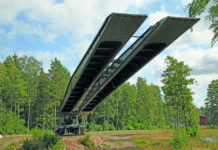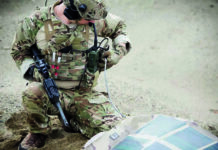Free-Space Optical (FSO) Wireless, or laser communications, has been in use in the
commercial sector for years. It’s potential on the battlefield, though yet to be fully exploited, is now being taken evermore seriously.
Imagine a means of line-of-sight communications that is totally secure, cannot be intercepted, eavesdropped, or disrupted by EW and jamming. Well, the commercial sector has been developing and using FSO technology over the past 30 years or more for a wide range of applications and this article takes a look at the technology, its development, and its potential in defence.
The Technology
FSO technology uses laser beams via a line-of-sight optical bandwidth connection to transfer data, video or voice communications across areas ranging typically from 100m to a few kilometres at throughput bandwidths up to 1.5Gbps at frequencies above 300GHz of wavelengths, typically, 785nm to 1550nm. Using FSO wireless networks eliminates the need to secure licensing found with RF signal solutions and also the expensive costs of laying fibre-optic cable. The practical side of FSO communication requires a pair of transceiver units housing an optical receiver and transmitter, allowing the sending and receiving of data simultaneously. The unit at one location transmits a beam of focused light carrying/delivering information directly to the receiving location where the light beam is transferred to an optical fibre from a high-sensitivity receiver. FSO systems offer various advantages over normal RF wireless networks; they don’t suffer from RF interference or band saturation, their operation is licence free, no software is needed on client devices, indoor installation is possible and unaffected by operation through glass and, importantly for the defence sector, FSO provides a very high level of security – the technology is already certified in governmental and defence applications for transferring confidential and classified information.
Due to the signal strength being affected by atmospheric conditions over increasing distance, the most efficient terrestrial FSO wireless network ranges are typically between 100m and 2km. However, when combined with LAN or WLAN networks they can provide very effective solutions to many scenarios, for example, by providing a bridge between WLAN-to-WLAN connections on campuses at Fast Ethernet or Gigabit Ethernet speeds to cater for many subscribers simultaneously. Alternatively, FSO can provide a bridge between LAN-to-LAN connections and they can also create a wireless link across an area where no physical access is possible. They can also be used to quickly re-establish high-speed network connections after incidents, as in disaster-recovery scenarios.
The speeds delivered by FSO are, today, comparable to those of optical-fibre connections, but with the flexibility and practicality of being part of a wireless network providing bandwidth speeds up to 10Mbps, 100Mbps, 155Mbps and 1.5Gbps; speeds of up to 10Gbps are likely in the future. Currently, the only other wireless technology capable of such speeds is Millimetre-Wave RF Wireless Networking, which, in comparison, requires licensing and can be affected severely by rain.
That is not to say FSO doesn’t have some atmospheric drawbacks. Unlike rain and snow, which generally have little effect on FSO communication, it is fog and water vapour droplets that hinder FSO operating performance; small water droplets can prevent light beams being received due absorption, refraction, scattering, or even complete reflection, which can significantly lower data rates. Line-of-Sight obstructions also interfere with FSO wireless transmission. As light can’t travel through opaque mediums, objects such as birds, planes and people can momentarily interrupt the service by blocking the beam, with service resuming instantly when the light path is cleared. Multi-beam technology can counter this problem to an extent. On occasions, building sway due to wind can also be a problem; it disrupts alignment between two transceiver units causing signal loss. On the safety side of FSO, the technology is strictly controlled, standards are followed and dangers limited, with equipment typically meeting Class 1M, eye-safe certification.
Commercial Sector Expertise
For the defence sector to see how far FSO has come, a look at progress and developments through the eyes of one of the technology’s leading pioneers over 25 years is worthwhile. CableFree Solutions, now named Wireless Excellence, developed some of the world’s first successful FSO links, including the first commercial 622Mbps wireless link in 1997 and the first Gigabit Ethernet 1.25Gbps wireless link in 1999. In 2003, the company launched a range of Enterprise Laser Connectivity products, the LaserHop family, for short-range communications of around 0.5 km for corporate campus or urban applications requiring high-speed, high-capacity transmission between different sites. Those plug-and-play systems were all Class 1M eye safe and delivered E1 and T1 service interfaces for voice, as well as fast Ethernet and Gigabit Ethernet for the transmission of high-speed backbone data.
With such advances almost 20 years ago, it is not as if the defence industry has to re-invent the wheel when considering adapting FSO for military applications. Today, FSO tech from Wireless Excellence is used in thousands of mission-critical customer networks worldwide, with diverse applications including: 4G/LTE backhaul, CPRI fronthaul, 3G and 2G networks, corporate networks, finance, energy, oil and gas exploration, power utilities, education, healthcare, broadcast with HD-SDI video, perimeter security and CCTV networks. One of the company’s highest profile involvements in recent years was at the 2012 London Olympics, where it supplied the BBC with high-definition Gigabit wireless video links to transmit live interviews with Team GB participants.
If further convincing is needed as to the potential of FSO as a secure means of communications in defence applications, Stephen Patrick, Wireless Excellence CEO, told ESD, “Of all current wireless technologies, FSO remains the most inherently secure technology for secure communications. Virtually impossible to detect, intercept or jam, the ultra-narrow beams used by FSO communications contrast with the much wider beams used by contemporary microwave, millimetre wave, or radio links. With almost limitless spectrum available, FSO has potential for huge bandwidth, as well as dense spatial re-use in busy urban areas without risk of congestion. For applications where FSO can’t meet requirements alone, the technology can be combined into hybrid RF+FSO solutions, where the diverse technologies can yield far higher uptime, range and capacity than any technology alone.”
Potential on the Battlefield
The full potential of FSO in the defence sector is now being researched and promoted by allied military/US DoD and defence industry players for both battlefield communications and space-based purposes. On today’s increasingly-connected, though threat-compromised battlefield, unprecedented levels of secure bandwidth and connectivity are required to maintain basic tactical communications, as well as disseminating large amounts of data from the growing numbers of battlefield sensors aboard vehicles and individual soldiers, securely and often in real time. Whether on land, in the air, at sea or in space, reliable high-capacity, high-speed connectivity are essential in each domain. Sole reliance on traditional RF communication, however, is vulnerable to detection and intercept and in highly contested and congested battlespace, gives adversaries the chance to jam or intercept critical communications, or to direction-find and engage. That is why new, complementary technologies need to be embraced to overcome these technological weaknesses and deliver military advantage. One leading defence player taking FSO tech very seriously, as a result, is QinetiQ. It sees FSO offering true innovation to potentially unlock quantifiable increases in military capability. In defence scenarios requiring enhanced connectivity, Qinetiq sees FSO offering a real alternative to transform the military battlespace by replacing much slower legacy communications with a fibre-optic-level of experience with multi-Gigabyte data capabilities. And echoing the sentiments of the commercial sector about inherent security, Qinetiq recognises that whilst not intended to replace RF communication, there are scenarios where a direct and secure transfer of data makes more sense, with FSO best placed to complement RF technologies as part of an overall network architecture. FSO communications are almost impossible to intercept or detect; the laser beam travels directly from platform to platform over a very narrow path. For it to be intercepted would require an adversary to get physically in the beam’[s path – something extremely difficult and easily detected.
Improved survivability is another plus for FSO. In modern conflicts, precision targeting using RF communications signatures is widespread, but using FSO the overall RF signature of any forces will vastly reduce, greatly increasing survivability by limiting RF footprint and, thereby, the ability of an adversary to intercept, jam, spoof, direction-find and strike. In addition, as FSO technology has an inherently low probability of detection or intercept, the need for complex encryption/decryption is reduced. This means that reliance on nationally-sovereign cryptography is lessened and interoperability of data exchange between allies can be increased. There is also an ISR capability that can be enhanced through the use of FSO wireless, with FSO equipment potentially being configured to switch between communications mode and ISR sensing functions.
At this time, Qinetiq has developed core FSO wireless technology that’s working across all domains, with FSO wireless concepts being developed and prototypes fielded. All these developments are being supported by modelling and simulation highlighting FSO’s ability to deliver information advantage to the user. Evaluation includes accurate cueing, pointing, vibration mitigation, target tracking, turbulence mitigation and other areas required to create a domain-appropriate FSO communication system suitable for military use. The company is currently looking at a core FSO wireless module that militaries can integrate into existing capabilities; such a module would provide a communications link and sensing modes scalable for different applications, incorporated into ruggedised housings to suit different deployment conditions and platforms, ultimately providing a rapid route to early adoption of an FSO communications capability.
FSO in Space
The use and potential for FSO in the space domain is huge. One leading pioneer, delivering telecommunication payloads for satellites, is Tesat, which has been using space-based laser communications for years. Its FSO terminals can transmit data and images between satellites and from satellites to earth with high transfer rates of 5.5 Gbps, equivalent to 200,000 pages of information per second. Head of Communications at Tesat, Nina Backes, told ESD that the company demonstrated FSO communication in space for the first time in 2007 between two satellites in LEO orbit. “This was the starting point to develop products for different use cases.” Today, one major user is the EDRS (European Data Relay System) uses Tesat’s LCT135 optical link on its LEO Earth observation satellites and its GEO satellites, to provide fast access to the data of the LEO bird.
“In this system the laser connection is between the LEO and the GEO satellite, therefore on both satellites one LCT135 is mounted. In the EDRS System TESAT has installed six of its LCT135s, which have the function to transmit data in the GEO Relay Mission.” In addition, she said that Sentinel satellites of the Copernicus Mission and two Pléiades Neo satellites also use the company’s laser communication terminals. “In 2023, TESAT will deliver LCTs for Compasso and Titania, as well as for a programme with the US Government.”
As to the challenges and threats of ensuring uninterrupted line-of-sight between laser origin and target in orbit Backes said that TESAT develops its own PAT (pointing acquisition and tracking) scheme, to allow a beaconless acquisition. “The accuracy of optical light needs to be really high. Most of us have used laser pointers during presentations in school or university. Even at this short distance of metres the light point makes little jumps on the board. Imagine Tesat having to handle these over a distance of 80,000 km.” She said calculations are made to lessen this issue and determine satellite position and the direction the LCT unit needs to point in, even if a satellite isn´t visible at a given moment.
Currently, Tesat is working on solutions for major constellations that are delivering global Internet access from space. For this, Tesat has developed its SCOT80 (Scalable Optical Terminal), which consists of an optical head and an electronic unit, produced in line with what Backes calls the ‘New Space approach’, which aims to work with COTS (commercial of the shelf) parts as much as possible. As to what’s next in the defence space sector, Backes told ESD that with the US DoD’s SDA (Space Development Agency) currently working on a huge satellite constellation programme, the main goals are to develop higher data rate capabilities for FSO in space and to increase the distance between two counterparts.
NASA’s ARTEMIS programme, to put a permanent base on the Moon, is also in Tesat’s FSO sights. “Another important topic,” Backe added, “is quantum encryption and the transmission of quantum-encrypted data via laser links. Tesat will manufacture the quantum payload for the first European quantum satellite, EAGLE.”












